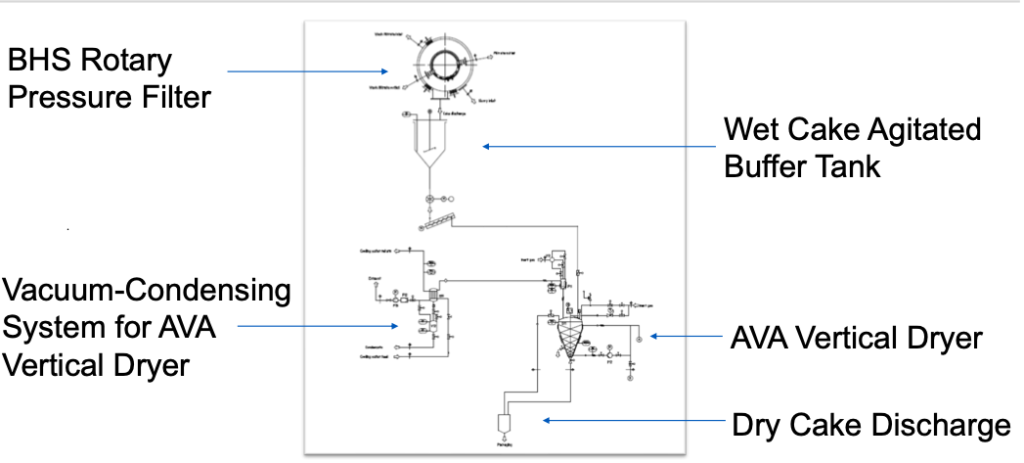Every year I look forward to attending AICHE, learning from peers, and sharing what knowledge I’ve gained in the past year. COVID-19 pushed us to meet virtually this year. Still, I was pleased to continue to share my talk on BHS-Sonthofen Inc.’s continuum approach to optimizing downstream final drying with upstream solid-liquid filtration. I thought I’d offer a recap here for those who missed the online event.
Most often when analyzing a new process development approach, engineers take a “silo” approach and look at each step independently. I suggest that by taking a holistic approach and looking at each step not individually but as a continuum, the process solution becomes much more efficient. I highlighted my perspective with data showing how to balance each of process steps for maximum efficiency.
My discussion of process filtration and optimizing downstream final drying centered on a specialty chemical process that has crystals in a methanol slurry which must be filtered, washed, dewatered and then dried. In looking to expand the existing process our objectives were to:
- Migrate to continuous operation from batch operation
- Maximize solid-liquid filtration performance
- Achieve low wash ratios for minimum wash media consumption
- Accomplish lowest possible residual moisture in discharged filter cake
- Reach final moisture of <1.0%
Testing a Continuum Approach to Optimizing Final Drying
The standard approach is to optimize the solid-liquid filtration step with maximum washing and pre-drying efficiency, Then, with this information we’d optimize the downstream drying. However, the client wanted us to look at the process as a continuum from solid-liquid filtration through cake washing and dewatering to final drying.
Our testing started at BHS-Sonthofen in Charlotte labs with our Pocket Leaf Filter. Starting with the slurry, we tested for cake thickness, pressure filtration, filter media, cake washing and drying and discharge.
The flux rate of less than two minutes at @ 200 kg DS/m2/hour) indicated this process was suitable for continuous operation. The cake drying moisture content, varying between 11 – 30%, was another positive indicator for an integrated approach.

Our lab testing of the slurry led us to recommend a continuous approach using the BHS Rotary Pressure Filter, which conducts pressures, cake watering, dewatering, and cake discharge all, continuously, in a slowly-rotating sealed drum. In testing for this client we achieved:
- Media = 14 micron and a cake thickness of 25 mm
- Desired filtration times and filtrate quality
- Efficient wash ratios of 0.7 to 1.2 kg MeOH/kg DS
- Moisture content varying between 11 – 30% based upon the nitrogen for blowing for drying
Based on the moisture of 11%, we sized the Rotary Pressure Filter filtration area at 2.88 m2 with a nitrogen solvent recovery package to reduce the nitrogen usage. This led to the next step in the integrated process: looking at the dryers.
Optimization testing of AVA dryer
BHS Sonthofen last year acquired AVA dryer, so we turned to their vertical conical dryer for testing. This dryer’s cleanable, contained design conveys solids gently down and out, which was useful for this project’s specialty chemicals.
In pilot testing in Munich, Germany, we were able to determine what moisture level to use out of the pressure filter to get the best continuous approach to final drying. We initially designed a 2.88 m2 with 11% moisture, which led to a dryer of 1.93 m3 and a dryer cycle time of 35 minutes. That system would have cost the client $2 million.
However, our testing optimized the design to increase moisture out of a smaller filter and use a larger dryer for longer. This saved $500,000 on the total system.
The Continuous Optimized Design
- Filter Size: 1.44 m2 with 30% moisture using 200 m3/hr N2 + Vacuum
- Dryer Size: 3.0 m3
- Dryer Cycle Time: 60 minutes
- Total System Budget Price: $1.5 million

The optimized system with a continuum approach resulted in operational energy and nitrogen savings as well as lower capital and installation costs for a more reliable process.
I’d have liked to answer your questions about this approach in person. Still, I’d be happy to hear your thoughts. Contact me today!
1 Comment
Comments are closed.


So, by cutting the mechanical device (drum filter) size in half, almost trebling the moisture in the wet cake, increasing the vacuum-thermal device (the conical dryer) by >50%, your drying time only increases ~40% and overall system price dropped ~25%???
I’m not clear how this is possible as, a mechanical device is far less expensive than a vacuum-thermal device, the increase in wet cake moisture by almost 3x I would think, make the dryer the bottleneck.
Finally, has the operating cost of the system been factored into the initial savings? I would think operating a bigger drum filter with a smaller vacuum dryer would be less than a smaller filter and a bigger dryer.
Thoughts?